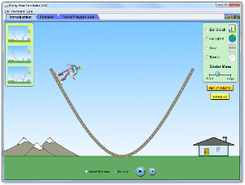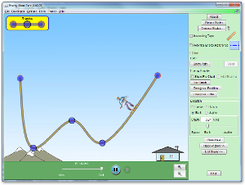|
GPE and KE >>
|
4.2 - Springs
Objectives:
- To know how to find the work done to stretch a spring
Elastic potential energy \(EPE\) or \(U_s\) is the energy that is stored in a stretched or squashed spring. It doesn't have to be a spring actually, but any material that can stretch or compress. There is a huge amount of stored energy in a highly tensioned wire or rope. At AP level it is assumed that the spring 'obeys' Hooke's Law. That is that the extension (stretch/squash) is directly proportional to the applied force. The more you stretch a spring the harder it is do stretch, or the more it wants to return back to its rest state. The elastic potential energy is equal to the work done in stretching or squashing the spring. This is numerically equal to the work done by the spring when it is released, assuming 100% efficiency. The derivation for this comes from the area under the \(F(x)\) graph.
\[EPE = U_{s}=\frac{1}{2}kx^{2}\]
Now, this is a very useful equation to memorise (which is easy as almost all things energy are in the form \(\frac{1}{2} constant \times variable^2\). AP examiners love spring loaded objects that are then launched upwards or sideways and then collide with something else or become a projectile. It is a good way to test a whole range of concepts!
\[EPE = U_{s}=\frac{1}{2}kx^{2}\]
Now, this is a very useful equation to memorise (which is easy as almost all things energy are in the form \(\frac{1}{2} constant \times variable^2\). AP examiners love spring loaded objects that are then launched upwards or sideways and then collide with something else or become a projectile. It is a good way to test a whole range of concepts!
GPE and KE >>

